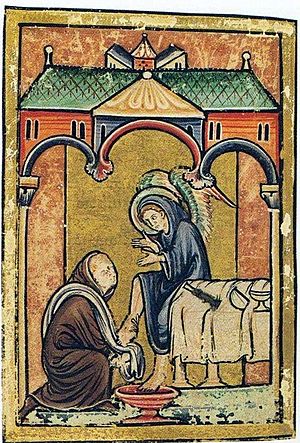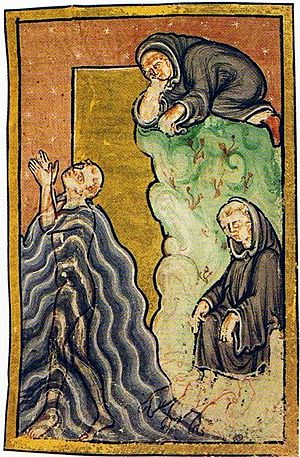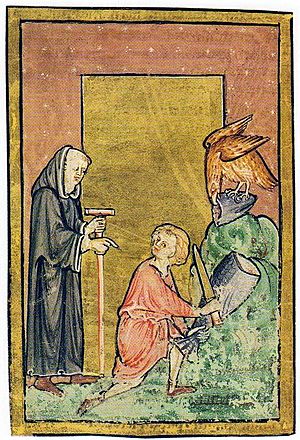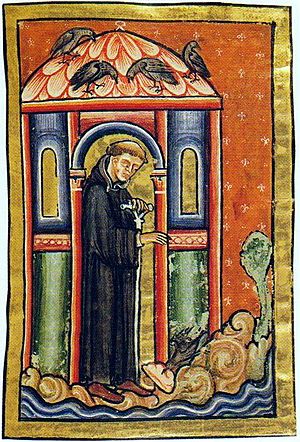Vita Sancti Cuthberti facts for kids
Quick facts for kids Vita Sancti Cuthberti |
|
|---|---|
| "The Life of St Cuthbert" | |
| Also known as | Vita sancti Cuthberti auctore anonymo |
| Author(s) | Anonymous |
| Patron | Eadfrith, bishop of Lindisfarne (698–721) |
| Language | Latin |
| Date | 699 × 705 |
| Provenance | Lindisfarne monastery |
| State of existence | Eight manuscripts |
| Bayerische Staatsbibliothek, Clm. 15817 | |
| St Omer 267 | |
| St Omer 715 | |
| Arras 812 (1029) | |
| British Library Harley MS 2800 | |
| Brussels Royal Library MSS 207–208 | |
| Trier, Public Library 1151 | |
| Paris, Bibliothèque Nationale, Fonds Latin 5289 | |
| First printed edition | The Bollandists, Acta Sanctorum Martii, vol. iii, (Antwerp, 1668), pp. 117–24 |
| Genre | prose hagiography |
| Subject | Cuthbert, bishop of Lindisfarne and Anglo-Saxon saint (died 687) |
| Setting | Northumbria |
| Period covered | 7th century |
The Vita Sancti Cuthberti (which means "Life of Saint Cuthbert" in English) is an old book from a long time ago. It was written in Northumbria during the early Middle Ages. It's probably the oldest "saint's life" (a story about a saint) that we still have from Anglo-Saxon England.
This book tells the story of Cuthbert (who died in 687). He was a monk and a hermit (someone who lives alone for religious reasons). Later, he became a bishop of Lindisfarne. The book also describes the many miracles he performed.
Eight copies of this book still exist today. They are found in old handwritten books called manuscripts across Europe. This book was a very important source for another famous writer, Bede, when he wrote his own books about Cuthbert.
The Vita Sancti Cuthberti was finished between 699 and 705 AD. The author is unknown, but we know he was a monk from the monastery of Lindisfarne. Because of this, it's often called the Anonymous Life to tell it apart from Bede's versions.
Contents
About the Book and Its Stories
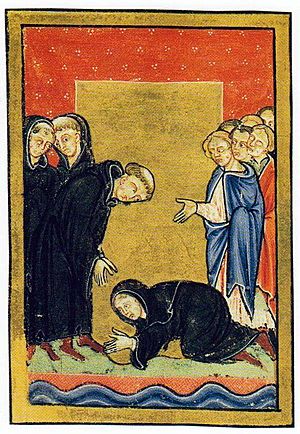
This book is one of the first Latin writings from Northumbria. It's also the earliest "hagiography" (saint's life story) written in English Latin.
The book tells about Cuthbert, who was a monk at Melrose. He then became a hermit on Farne Island. Later, he served as the bishop of Lindisfarne. He passed away on March 20, 687.
The book was asked for by Bishop Eadfrith. He was the bishop famous for creating the beautiful Lindisfarne Gospels. The Anonymous Life is divided into four parts, or "books." This was a special way to organize the story. It showed that the author thought Cuthbert was as important as other famous saints like Benedict of Nursia and Martin of Tours.
The author got most of his information from stories told by the monks at Lindisfarne. Many of these people were unnamed priests and deacons. But some important people were named, like Ælfflaed, Æthilwald, Plecgils, Tydi, and Walhstod.
Who Wrote It and When?
The Life of St Cuthbert was finished sometime between 699 and 705 AD. We know it couldn't be earlier than 699 because it talks about miracles that happened after Cuthbert's body was moved in 698. It also mentions that King Aldfrith was "now reigning peacefully." This means it was written before the king died in 705.
The person who wrote the book is not known. Some people have guessed who it might be, but no one is sure. However, we do know it was written by a monk from Lindisfarne. The author often uses words like "our" when talking about Lindisfarne and its monastery. This suggests the writer was part of that community.
Old Copies of the Book
The Anonymous Life exists in eight old handwritten copies, called manuscripts. The oldest one is in Munich, Germany. It was probably made in a place called Salzburg.
Another very old copy was likely made around 900 AD. It is considered the most accurate copy we have today. Other copies are found in places like Arras, France, and in the British Library in London.
These old copies show how the story of Saint Cuthbert was shared and read across Europe long ago.
Stories from the Book
The Anonymous Life has four main parts, or "books." Book one tells about Cuthbert's younger years. Book two covers his early time serving God. Book three describes his life as a hermit on Farne Island. And book four talks about his time as a bishop.
Book One: Cuthbert's Youthful Miracles
The first part of the book starts by saying that Bishop Eadfrith asked for the story to be written. When Cuthbert was eight years old, he became lame (couldn't walk well). An angel visited him and told him how to get better.
Later, as a young shepherd in Lauderdale, Cuthbert saw a vision. He saw a bishop being carried up to heaven. It turned out that Aidan, the bishop of Lindisfarne, had died at that exact moment.
One winter, Cuthbert was traveling and crossed the river Wear. He found shelter in an empty summer house. He was very hungry, but his horse found warm bread and meat on the roof of the house! The book also mentions other miracles from Cuthbert's youth. These include God providing food for him during a battle, him seeing a soul go to heaven, and him curing people who were ill.
Book Two: Early Years of Service
In book two, Cuthbert becomes a monk. When he was new to the monastery at Ripon, he was in charge of greeting guests. One time, he washed a visitor's feet. But he couldn't find any bread for the guest. When he came back, the visitor, who was an angel in disguise, had disappeared. But he left behind three warm loaves of bread!
Another time, Cuthbert went to the beach at night to pray. A cleric (a church helper) secretly followed him. The cleric saw two sea animals come out of the water. They gently cleaned and rubbed Cuthbert's feet! A priest named Plecgils told this story to the author.
Cuthbert and two brothers were sailing to the land of the Picts. They got hungry while waiting for the sea to calm down. But then, they found three pieces of cooked dolphin meat on the beach. It was enough to feed them for three days! A priest named Tydi told this story.
Tydi also told a story about Cuthbert and a boy walking along the river Teviot. They were teaching and baptizing people. An eagle landed nearby, and the boy found a fish. They shared half the fish with the eagle and ate the other half themselves.
The book also tells how Cuthbert saved his childhood nanny's house from fire through prayer. He also helped a woman by driving out a demon from her.
Book Three: The Hermit on Farne Island
Book three describes Cuthbert's time living alone on an island. After being a leader at Melrose, Cuthbert went to Lindisfarne. He then decided to live a more solitary life on Farne Island. There, he fought off demons and started building his home.
Cuthbert was very strong. He moved a huge rock for his building. He also told his men to dig in stony ground, and a fresh spring of water appeared! When his men couldn't find a 12-foot beam for his house, the ocean waves brought one to him.
Once, some ravens disturbed the roof of his servants' shelter. Cuthbert told them to leave the island. After three days, one raven returned, asking for forgiveness. Cuthbert forgave it, and both ravens then brought him enough pig lard to grease everyone's boots for a whole year!
Cuthbert was called to Coquet Island by Abbess Ælfflaed, the king's sister. She asked him about her brother, King Ecgfrith. Cuthbert predicted that the king would die soon and that Aldfrith would become king. Cuthbert also agreed to become a bishop within two years.
Book Four: Cuthbert as Bishop and Beyond
Cuthbert became the bishop of Lindisfarne in book four. He didn't want the job, but he accepted it. He continued to live a simple, monk-like life.
Many healing miracles are told in this part. Cuthbert cured the wife of one of King Aldfrith's men. He also cured a young girl from a village called Bedesfeld. A priest named Æthilwald, who was related to the girl, saw this miracle. Cuthbert also cured a boy who couldn't move (a paralytic) in the mountains.
In a story told by Tydi, Cuthbert saved a baby and its family from a terrible illness called the plague. He also saved a servant named Sibba, a story told by another monk who used to work for Sibba.
When King Ecgfrith was fighting the Picts, Cuthbert visited the queen. He announced that the war was over and that the king had been killed. It was later found out that this happened at the exact same time the king died in battle.
Cuthbert met a hermit named Hereberht. Hereberht asked to die on the same day and at the same hour as Cuthbert. Cuthbert agreed, and they both went to heaven at the same time on the same night.
Cuthbert later gave up his job as bishop after two years and went back to Farne Island. Miracles continued to happen. He cured a brother named Walhstod from a stomach illness. Cuthbert died on Farne, and his body was taken to Lindisfarne.
Eleven years later, Cuthbert's body was found to be "incorrupt." This means it had not decayed at all! Miracles then began to happen at Cuthbert's coffin. Prayers and holy water from where his body was washed cured a boy who was thought to be possessed by a demon. A monk who was very sick was cured after praying at Cuthbert's coffin. Another young man who couldn't move was cured after wearing shoes that Cuthbert had once worn.
The author ends the book by saying he left out many other miracles so that the reader wouldn't get tired!
How This Book Is Different from Bede's Story
The Anonymous Life was the main source for Bede when he wrote his two famous books about Cuthbert's life. However, Bede didn't really say that he used the Anonymous Life as his source. If we only had Bede's books, we might not even know this older book existed!
The Latin writing in the Anonymous Life is not as fancy or perfect as Bede's. Bede tried to make the writing better. Bede also added some small details to his own stories. But mostly, he just changed the words and added more "saintly" descriptions.
Bede changed the order of some of the miracles in his book. The Anonymous Life says Cuthbert started his religious life at Ripon. But Bede shows that he actually started at Melrose. Bede also added a longer story about Cuthbert's death. He also included stories about a goose on Farne and information about Cuthbert's successors (the people who took his place) on Farne.


